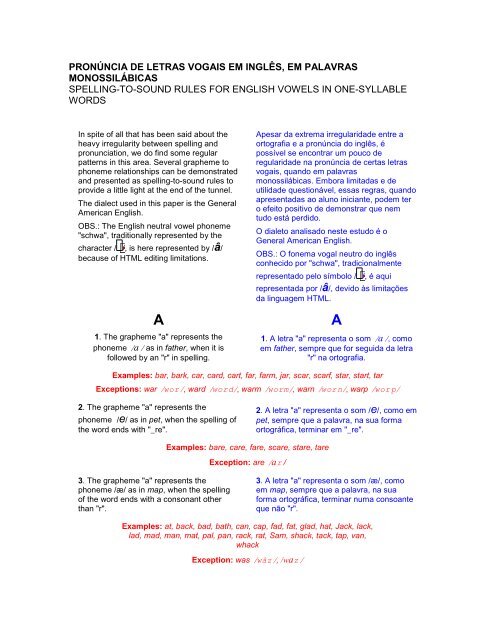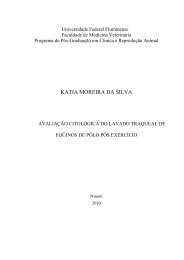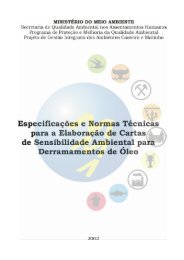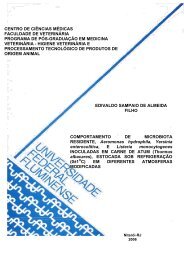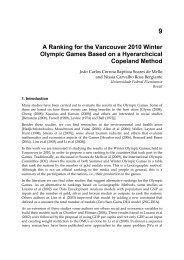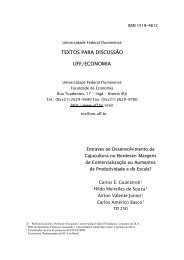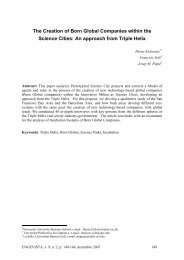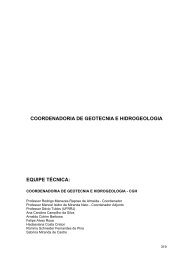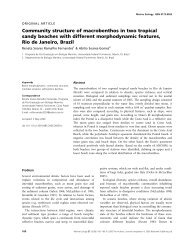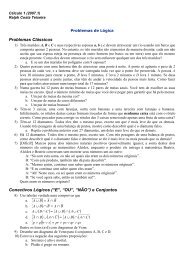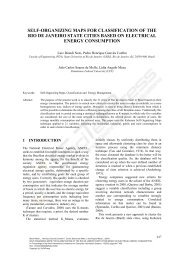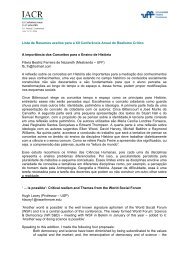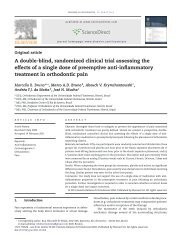apostila - inglês pronúncia de letras vogais em inglês - UFF
apostila - inglês pronúncia de letras vogais em inglês - UFF
apostila - inglês pronúncia de letras vogais em inglês - UFF
You also want an ePaper? Increase the reach of your titles
YUMPU automatically turns print PDFs into web optimized ePapers that Google loves.
PRONÚNCIA DE LETRAS VOGAIS EM INGLÊS, EM PALAVRAS<br />
MONOSSILÁBICAS<br />
SPELLING-TO-SOUND RULES FOR ENGLISH VOWELS IN ONE-SYLLABLE<br />
WORDS<br />
In spite of all that has been said about the<br />
heavy irregularity between spelling and<br />
pronunciation, we do find some regular<br />
patterns in this area. Several graph<strong>em</strong>e to<br />
phon<strong>em</strong>e relationships can be <strong>de</strong>monstrated<br />
and presented as spelling-to-sound rules to<br />
provi<strong>de</strong> a little light at the end of the tunnel.<br />
The dialect used in this paper is the General<br />
American English.<br />
OBS.: The English neutral vowel phon<strong>em</strong>e<br />
"schwa", traditionally represented by the<br />
character / /, is here represented by /â/<br />
because of HTML editing limitations.<br />
A<br />
1. The graph<strong>em</strong>e "a" represents the<br />
phon<strong>em</strong>e /a/ as in father, when it is<br />
followed by an "r" in spelling.<br />
Apesar da extr<strong>em</strong>a irregularida<strong>de</strong> entre a<br />
ortografia e a <strong>pronúncia</strong> do <strong>inglês</strong>, é<br />
possível se encontrar um pouco <strong>de</strong><br />
regularida<strong>de</strong> na <strong>pronúncia</strong> <strong>de</strong> certas <strong>letras</strong><br />
<strong>vogais</strong>, quando <strong>em</strong> palavras<br />
monossilábicas. Embora limitadas e <strong>de</strong><br />
utilida<strong>de</strong> questionável, essas regras, quando<br />
apresentadas ao aluno iniciante, po<strong>de</strong>m ter<br />
o efeito positivo <strong>de</strong> <strong>de</strong>monstrar que n<strong>em</strong><br />
tudo está perdido.<br />
O dialeto analisado neste estudo é o<br />
General American English.<br />
OBS.: O fon<strong>em</strong>a vogal neutro do <strong>inglês</strong><br />
conhecido por "schwa", tradicionalmente<br />
representado pelo símbolo / /, é aqui<br />
representada por /â/, <strong>de</strong>vido às limitações<br />
da linguag<strong>em</strong> HTML.<br />
A<br />
1. A letra "a" representa o som /a/, como<br />
<strong>em</strong> father, s<strong>em</strong>pre que for seguida da letra<br />
"r" na ortografia.<br />
Examples: bar, bark, car, card, cart, far, farm, jar, scar, scarf, star, start, tar<br />
Exceptions: war /wor/, ward /word/, warm /worm/, warn /worn/, warp /worp/<br />
2. The graph<strong>em</strong>e "a" represents the<br />
phon<strong>em</strong>e /e/ as in pet, when the spelling of<br />
the word ends with "_re".<br />
3. The graph<strong>em</strong>e "a" represents the<br />
phon<strong>em</strong>e /æ/ as in map, when the spelling<br />
of the word ends with a consonant other<br />
than "r".<br />
Examples: bare, care, fare, scare, stare, tare<br />
Exception: are /ar /<br />
2. A letra "a" representa o som /e/, como <strong>em</strong><br />
pet, s<strong>em</strong>pre que a palavra, na sua forma<br />
ortográfica, terminar <strong>em</strong> "_re".<br />
3. A letra "a" representa o som /æ/, como<br />
<strong>em</strong> map, s<strong>em</strong>pre que a palavra, na sua<br />
forma ortográfica, terminar numa consoante<br />
que não "r".<br />
Examples: at, back, bad, bath, can, cap, fad, fat, glad, hat, Jack, lack,<br />
lad, mad, man, mat, pal, pan, rack, rat, Sam, shack, tack, tap, van,<br />
whack<br />
Exception: was /wâz/, /waz/
4. The graph<strong>em</strong>e "a" represents the<br />
phon<strong>em</strong>e /ey / as in table, when the<br />
spelling of the word ends with a consonant<br />
other than "r" followed by the letter "e".<br />
4. A letra "a" representa o som /ey /, como<br />
<strong>em</strong> table, s<strong>em</strong>pre que a palavra, na sua<br />
forma ortográfica, terminar numa consoante<br />
que não "r", seguida da letra "e".<br />
Examples: ate, bake, ba<strong>de</strong>, bathe, cane, cape, fa<strong>de</strong>, fate, gla<strong>de</strong>,<br />
hate, Jake, lake, la<strong>de</strong>, ma<strong>de</strong>, male, mane, mate, pale, pane, pave,<br />
rake, rate, same, shake, take, tape, vane<br />
5. The graph<strong>em</strong>e "a" represents the<br />
phon<strong>em</strong>e /o/ as in dog and law, when it is<br />
followed by an "l" in spelling.<br />
Exception: have /hæv/<br />
5. A letra "a" representa o som /o/, como <strong>em</strong><br />
dog e law, s<strong>em</strong>pre que for seguida da letra<br />
"l" na ortografia.<br />
Examples: bald, ball, call, chalk, fall, hall, mall, stalk, talk, tall, walk, wall<br />
E<br />
6. The graph<strong>em</strong>e "e" represents the<br />
phon<strong>em</strong>e /e/ as in pet, when the spelling of<br />
the word ends with a consonant other than<br />
"w" and "y".<br />
Exception: pal /pæl/, calm /kam/<br />
E<br />
6. A letra "e" representa o som /e/, como<br />
<strong>em</strong> pet, s<strong>em</strong>pre que a palavra, na sua forma<br />
ortográfica, terminar <strong>em</strong> consoante menos<br />
"w" e "y".<br />
Examples: bet, check, <strong>de</strong>ck, fell, kept, left, lend, melt, pet, pen, rent, spell, tell, ten,<br />
vet, well, when<br />
7. The graph<strong>em</strong>e "e" represents the<br />
phon<strong>em</strong>e /â/ as in bird and but, when it is<br />
followed by an "r" in spelling.<br />
7. A letra "e" representa o som /â/, como<br />
<strong>em</strong> bird e but, s<strong>em</strong>pre que for seguida <strong>de</strong> "r"<br />
na ortografia.<br />
Examples: berg, Bert, clerk, nerd, per, sperm, term, verb, were<br />
I<br />
8. The graph<strong>em</strong>e "i" represents the<br />
phon<strong>em</strong>e /I/ as in hit, when the spelling of<br />
the word ends with a consonant other than<br />
"gh" and "ght".<br />
Exceptions: where /wher/, mere /mIr/<br />
I<br />
8. A letra "i" representa o som /I/, como <strong>em</strong><br />
hit, s<strong>em</strong>pre que a palavra, na sua forma<br />
ortográfica, terminar <strong>em</strong> consoante, menos<br />
"gh" e "ght".<br />
Examples: bit, dim, fill, fin, kit, lip, mill, pick, pill, pin, rip, six, spit, till, tilt, will, win<br />
9. The graph<strong>em</strong>e "i" represents the<br />
diphthong /ay/ as in my, when the spelling of<br />
the word ends with "_gh" or "_ght".<br />
9. A letra "i" representa o som /ay/, como <strong>em</strong><br />
my, s<strong>em</strong>pre que a palavra, na sua forma<br />
ortográfica, terminar <strong>em</strong> "gh" ou "ght".
Examples: high, thigh, fight, light, might, night, right, tight<br />
10. The graph<strong>em</strong>e "i" represents the<br />
diphthong /ay/ as in my, when the spelling<br />
of the word ends with "_e".<br />
10. A letra "i" representa o som /ay/, como<br />
<strong>em</strong> my, s<strong>em</strong>pre que a palavra, na sua forma<br />
ortográfica, terminar com a letra "e".<br />
Examples: bite, dime, dive, file, fine, five, kite, knife, lie, mile, nine,<br />
pie, pike, pile, pine, ripe, site, spite, strive, tile, while, wine, wire<br />
11. The graph<strong>em</strong>e "i" represents the<br />
phon<strong>em</strong>e /â/ as in bird, when it is followed by<br />
an "r" in spelling.<br />
Exceptions: give /gIv/, live /lIv/<br />
11. A letra "i" representa o som /â/, como <strong>em</strong><br />
bird, s<strong>em</strong>pre que for seguida da letra "r" na<br />
ortografia.<br />
Examples: dirt, firm, flirt, irk, Kirk, shirt, skirt, stir, whirl<br />
O<br />
12. The graph<strong>em</strong>e "o" represents the<br />
phon<strong>em</strong>e /a/ as in father, when in spelling:<br />
1) it is not followed by an "r";<br />
2) the word ends with any consonant but<br />
"_w".<br />
O<br />
12. A letra "o" representa o som /a/, como<br />
<strong>em</strong> father, s<strong>em</strong>pre que na ortografia:<br />
1) não seja seguida da letra "r";<br />
2) a palavra terminar <strong>em</strong> qualquer<br />
consoante, menos "w".<br />
Examples: bomb, bond, clock, con, cop, cot, flop, glob, hop, hot, mod, mop, not, on, pond,<br />
rob, tom, top<br />
Exceptions: comb /kowm/, dog /dog/, from /frâm/, tomb /tuwm/, ton /tân/<br />
13. The graph<strong>em</strong>e "o" represents the<br />
phon<strong>em</strong>e /ow/ as in go, when the spelling<br />
of the word ends with "_e".<br />
13. A letra "o" representa o som /ow/, como<br />
<strong>em</strong> go, s<strong>em</strong>pre que a palavra, na sua forma<br />
ortográfica, terminar com a letra "e".<br />
Examples: clove, cope, cote, globe, hope, mo<strong>de</strong>, mope, note, robe, tone, tope<br />
Exceptions: done /dân/, love /lâv/, none /nân/, gone /gon/<br />
14. The graph<strong>em</strong>e "o" represents the<br />
phon<strong>em</strong>e /o/ as in dog and law, when it is<br />
followed by an "r" in spelling.<br />
14. A letra "o" representa o som /o/, como<br />
<strong>em</strong> dog e law, s<strong>em</strong>pre que for seguida da<br />
letra "r" na ortografia.<br />
Examples: born, corn, horn, lord, norm, pork, port<br />
Exceptions: word /wârd/, world /wârld/, worm /wârm/<br />
U<br />
15. The graph<strong>em</strong>e "u" represents the<br />
phon<strong>em</strong>e /â/ as in but, when the spelling of<br />
U<br />
15. A letra "u" representa o som /â/, como<br />
<strong>em</strong> but, s<strong>em</strong>pre que a palavra, na sua forma
the word ends with a consonant. ortográfica, terminar <strong>em</strong> consoante.<br />
Examples: blurb, cub, curt, cut, duck, dull, hug, purr, tub, up<br />
16. The graph<strong>em</strong>e "u" represents the<br />
phon<strong>em</strong>e /uw/ or the diphthong /yuw/ as<br />
in too or you, when the spelling of the word<br />
ends with "_e".<br />
Exception: pull /pUl/<br />
16. A letra "u" representa os sons /uw/ ou<br />
/yuw/, como <strong>em</strong> too ou you, s<strong>em</strong>pre que a<br />
palavra, na sua forma ortográfica, terminar<br />
com a letra "e".<br />
Examples: cube, cure, cute, duke, huge, pure, tube<br />
Exceptions: sure /shUr/, curve /kârv/


